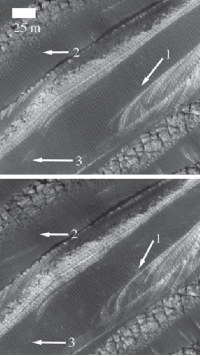The Winds of Mars

Images taken 1363 days apart.
In two different papers published in two different journals in the past month, scientists have concluded that — despite the thinness of the planet’s atmosphere — the dunes and sands of Mars are being continually shaped and changed by its winds. In both papers the data from which this conclusion was drawn came from high resolution images taken by the HiRISE camera on Mars Reconnaissance Orbiter.
What is especially interesting about this conclusion is that the climate models that had been developed for the Martian atmosphere, combined with wind measurements gathered by the various Martian landers, had all suggested that the kind of strong winds necessary to move sand were rare. To quote the abstract of the paper published on Monday in the journal Geology, Bridges, et al,
Prior to Mars Reconnaissance Orbiter data, images of Mars showed no direct evidence for dune and ripple motion. This was consistent with climate models and lander measurements indicating that winds of sufficient intensity to mobilize sand were rare in the low-density atmosphere.
Similarly, the second paper, Silvestro, et al, published on October 22 in Geophysical Research Letters, stated that
results from wind tunnel simulations and atmospheric models show that such strong wind events should be rare in the current Martian atmospheric setting.
Yet, both studies found significant evidence that such winds do occur on Mars, and are moving sand in many different places.
Silvestro et al for example found that the dunes in one particular dune field in Meridiani Planum were advancing approximately 1.3 to 3.3 feet per Martian year. Bridges et al in turn found that “sand is mobile throughout the north polar sand seas and exhibits variability at other latitudes.” In one case two dunes moved 30 and 60 feet respectively during the two Martian years. They concluded that “winds in the present low-density atmosphere of Mars are sufficient to move dunes and ripples in many areas of the planet.”
At the same time, Bridges et al also found that many larger dune and ripple structures showed no changes at all, suggesting that they have been in place for a long time. In order for these ripple and dune patterns to have been formed by winds, the Martian atmosphere would have had to be denser (thereby producing stronger more frequent winds), something that scientists believe might have occurred anywhere from 50,000 to 200,000 years ago, caused by the natural changes in the obliquity, inclination, and precession of the Martian orbit and rotation.
What can we draw from these results? First, it shows once again the dangers of assuming your data or models are complete. The closer we look, the more we learn, every time.
Second, the data illustrates that Mars is still a dynamic planet, albeit a relatively quiet one when compared to the Earth.
Third, the data is further proof that the Martian climate has changed drastically over the eons. Now its winds can move sand, but only in limited ways. Once, however, that atmosphere was denser and those winds were stronger, creating landforms that today appear cemented in place and unchanging.
On Christmas Eve 1968 three Americans became the first humans to visit another world. What they did to celebrate was unexpected and profound, and will be remembered throughout all human history. Genesis: the Story of Apollo 8, Robert Zimmerman's classic history of humanity's first journey to another world, tells that story, and it is now available as both an ebook and an audiobook, both with a foreword by Valerie Anders and a new introduction by Robert Zimmerman.
The print edition can be purchased at Amazon or from any other book seller. If you want an autographed copy the price is $60 for the hardback and $45 for the paperback, plus $8 shipping for each. Go here for purchasing details. The ebook is available everywhere for $5.99 (before discount) at amazon, or direct from my ebook publisher, ebookit. If you buy it from ebookit you don't support the big tech companies and the author gets a bigger cut much sooner.
The audiobook is also available at all these vendors, and is also free with a 30-day trial membership to Audible.
"Not simply about one mission, [Genesis] is also the history of America's quest for the moon... Zimmerman has done a masterful job of tying disparate events together into a solid account of one of America's greatest human triumphs."--San Antonio Express-News


I wonder how big the difference in density of the atmosphere is on mars between the areas of highest and lowest elevation or maybe in very deep caves how much denser could the atmosphere get?